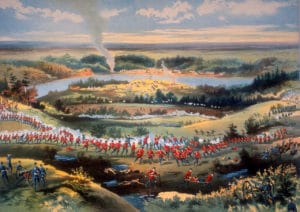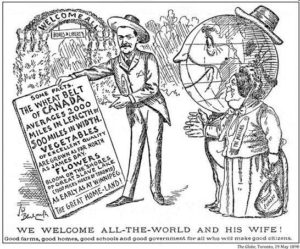In 1870, Canada acquired the Hudson’s Bay Company’s territories and formed the North-West Territories to administer the vast territory between British Columbia and Manitoba. The Crown also entered into a series of numbered treaties with the indigenous peoples of the area, which serve as the basis of the relationship between First Nations, as they are called today, and the Crown. Since the late twentieth century, land losses and inequities as a result of those treaties have been subject to negotiation for settlement between the First Nations in Saskatchewan and the federal government, in collaboration with provincial governments.
In 1876, following their defeat of United States Army forces at the Battle of the Little Bighorn in Montana Territory in the United States, the Lakota Chief Sitting Bull led several thousand of his people to Wood Mountain. Survivors and descendants founded Wood Mountain Reserve in 1914.
The North-West Mounted Police set up several posts and forts across Saskatchewan, including Fort Walsh in the Cypress Hills, and Wood Mountain Post in south-central Saskatchewan near the United States border.

Many Métis people, who had not been signatories to a treaty, had moved to the Southbranch Settlement and Prince Albert district north of present-day Saskatoon following the Red River Rebellion in Manitoba in 1870. In the early 1880s, the Canadian government refused to hear the Métis’ grievances, which stemmed from land-use issues. Finally, in 1885, the Métis, led by Louis Riel, staged the North-West Rebellion and declared a provisional government. They were defeated by a Canadian militia brought to the Canadian prairies by the new Canadian Pacific Railway. Riel, who surrendered and was convicted of treason in a packed Regina courtroom, was hanged on November 16, 1885. Since then, the government has recognized the Métis as an aboriginal people with status rights and provided them with various benefits.
European Settlements:
The national policy set by the federal government, the Canadian Pacific Railway, the Hudson’s Bay Company and associated land companies encouraged immigration. The Dominion Lands Act of 1872 permitted settlers to acquire one quarter of a square mile of land to homestead and offered an additional quarter upon establishing a homestead. In 1874, the North-West Mounted Police began providing police services. In 1876, the North-West Territories Act provided for appointment, by the Ottawa, of a Lieutenant Governor and a Council to assist him.

Highly optimistic advertising campaigns promoted the benefits of prairie living. Potential immigrants read leaflets information painted Canada as a veritable garden of Eden and downplayed the need for agricultural expertise. Ads in The Nor’-West Farmer by the Commissioner of Immigration implied that western land was blessed with water, wood, gold, silver, iron, copper, and cheap coal for fuel, all of which were readily at hand. Reality was far harsher, especially for the first arrivals who lived in sod houses. However eastern money poured in and by 1913, long term mortgage loans to Saskatchewan farmers had reached $65 million.
